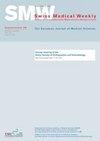Exploring the feasibility and safety of laparoscopic anti-reflux surgery with the new RefluxStop™ device: a retrospective cohort study of 40 patients
IF 2.1
4区 医学
Q2 MEDICINE, GENERAL & INTERNAL
引用次数: 0
Abstract
AIMS OF THE STUDY: Anti-reflux surgery aims to restore the anti-reflux barrier and reduce the retrograde flow of stomach contents. However, traditional surgical techniques generally involve some degree of encircling of the oesophagus, which can result in adverse effects such as dysphagia and the inability to belch or vomit. Based on the first published results, a novel surgical technique – with the RefluxStop™ device – appears promising for treating gastroesophageal reflux disease (GERD) with minimal postoperative dysphagia. This study describes the initial clinical experience with this procedure in a cohort of patients with chronic gastroesophageal reflux disease to evaluate its feasibility and safety in clinical practice. METHODS: This retrospective cohort study examined the first 40 patients who underwent laparoscopic anti-reflux surgery with the RefluxStop™ device at a private hospital in Switzerland. The procedure involves implanting a nonactive device on the outside of the gastric fundus to stabilise a narrow oesophagogastric plication. Feasibility was assessed based on the proportion of patients in whom the device could be successfully implanted, with a discussion of the operative details. Intraoperative and postoperative complications, adverse effects, and changes in gastroesophageal reflux disease-related quality of life (GERD-HRQL questionnaire) are also reported. RESULTS: Between May 2020 and April 2022, 40 patients underwent elective surgery for laparoscopic hiatal hernia repair and RefluxStop™ device implantation. All patients had typical symptoms of gastroesophageal reflux disease, such as heartburn and regurgitation; 20 (50%) had preoperative dysphagia. Laparoscopic surgery was feasible in all patients except one who required laparotomy due to adhesions and associated bleeding when accessing the abdomen. The median operating time was 57.5 minutes (interquartile range = 51.75–64.25 minutes) with no device-related intraoperative or postoperative complications. All patients were imaged one day and three months postoperative, confirming the correct placement of the device. Reflux symptoms (heartburn and acid regurgitation) were significantly improved in all patients at three months (p <0.0001). CONCLUSION: These preliminary results support the feasibility and safety of introducing this novel laparoscopic anti-reflux surgical treatment option in clinical practice.探索使用新型 RefluxStop™ 设备进行腹腔镜抗反流手术的可行性和安全性:对 40 名患者进行的回顾性队列研究
研究目的:抗反流手术旨在恢复抗反流屏障,减少胃内容物逆流。然而,传统的手术技术通常会在一定程度上包围食道,从而导致吞咽困难、无法嗳气或呕吐等不良后果。根据首次公布的结果,使用 RefluxStop™ 设备的新型外科技术似乎有望治疗胃食管反流病(GERD),并将术后吞咽困难降至最低。方法:这项回顾性队列研究对瑞士一家私立医院使用 RefluxStop™ 装置进行腹腔镜抗反流手术的首批 40 名患者进行了检查。该手术是在胃底外侧植入一个非活动装置,以稳定狭窄的食道胃板。手术的可行性根据成功植入该装置的患者比例进行评估,并对手术细节进行讨论。结果:2020 年 5 月至 2022 年 4 月期间,40 名患者接受了腹腔镜食管裂孔疝修补和 RefluxStop™ 装置植入的择期手术。所有患者都有胃食管反流病的典型症状,如烧心和反流;20 人(50%)术前有吞咽困难。除了一名患者因粘连和进入腹部时伴有出血而需要开腹手术外,所有患者均可进行腹腔镜手术。中位手术时间为 57.5 分钟(四分位间范围 = 51.75-64.25 分钟),术中和术后均未出现与设备相关的并发症。所有患者都在术后一天和三个月接受了成像检查,确认了装置的正确放置。所有患者的反流症状(烧心和胃酸倒流)在术后三个月都得到了明显改善(P <0.0001)。
本文章由计算机程序翻译,如有差异,请以英文原文为准。
求助全文
约1分钟内获得全文
求助全文
来源期刊

Swiss medical weekly
医学-医学:内科
CiteScore
5.00
自引率
0.00%
发文量
0
审稿时长
3-8 weeks
期刊介绍:
The Swiss Medical Weekly accepts for consideration original and review articles from all fields of medicine. The quality of SMW publications is guaranteed by a consistent policy of rigorous single-blind peer review. All editorial decisions are made by research-active academics.
 求助内容:
求助内容: 应助结果提醒方式:
应助结果提醒方式:


